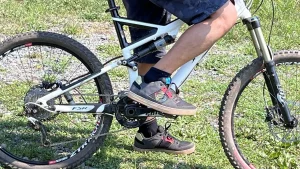Can Mobility Exercises Help with Strength Training?

Table of Contents
The Link Between Mobility and Strength
- Range of Motion (ROM): Mobility refers to the ability of a joint or a group of joints to move freely through their full range of motion. A sufficient range of motion is essential for performing strength exercises. For example, in a squat, adequate hip and ankle mobility allow proper depth, which is crucial for engaging the muscles of the lower body, including the quads and hamstrings.
- Joint Stability: Mobility exercises help strengthen the muscles surrounding your joints, improving joint stability. This enhanced stability allows you to lift heavier weights and perform more challenging exercises safely, leading to greater strength gains and limiting the risk of injuries to the ligaments around your joints during twisting exercises.
- Form and Technique: Mobility restrictions can compromise form and technique during strength exercises. For instance, limited shoulder mobility can affect your ability to maintain proper posture during overhead presses, increasing the risk of injury and reducing the effectiveness of the exercise. By improving mobility, you can maintain better alignment and execute exercises with proper technique.
- Injury Prevention: Poor mobility can increase the risk of injuries during strength training. By improving mobility, you reduce the risk of injuries caused by muscle imbalances, poor movement patterns, or overcompensation in surrounding muscles and tissues, leading to overuse injuries or strains. Staying injury-free enables you to maintain a consistent strength training routine and progress in your strength gains.
- Muscle Recruitment: When joints are restricted due to poor mobility, certain muscles may be underutilized or compensatory patterns may develop, leading to inefficiencies and potentially limiting strength gains. Greater mobility allows you to move through a full range of motion, recruiting more muscle fibers and maximizing the benefits of strength training. Proper mobility ensures muscles activate optimally for greater gains in a shorter timeframe.
- Enhanced Recovery: Improved mobility aids in muscle recovery, promoting blood flow and reducing muscle stiffness. This helps you recover more quickly between strength training sessions, enabling you to maintain a consistent routine and continue building strength.
How to Start Mobility Training
Starting mobility training is a simple process that can be easily integrated into your existing fitness routine. Follow these steps to get started:
- Assess Your Current Mobility: Begin by evaluating your current mobility levels. This can be done by performing a series of simple movements, such as squats, lunges, and shoulder rotations, and pay attention to areas of your body that feel tight or restricted during everyday movements or exercise. Common areas to assess include hips, shoulders, spine, ankles, and wrists.
- Set Mobility Goals: Set realistic goals based on your assessment, focusing on areas that need improvement. This could include increasing range of motion, improving posture, . Whether it’s improving flexibility, enhancing range of motion in specific joints, addressing mobility limitations that affect your performance in certain exercises or reducing pain or stiffness in specific joints, setting clear goals will help you stay focused and motivated.
- Educate Yourself: Take some time to learn about different mobility exercises and techniques. There are various resources available, including books, online articles, videos, and tutorials. Familiarize yourself with basic mobility drills and stretches that target areas of the body where movement feels restricted.
- Incorporate Dynamic Stretching: Before strength training sessions, perform dynamic stretches that move your joints through their full range of motion. This helps prepare your body for exercise and improves mobility over time.
- Use Foam Rolling: Incorporate foam rolling into your warm-up and cool-down routines. This self-myofascial release technique helps relieve muscle tension, improve blood flow, and enhance mobility.
- Add Mobility Exercises: Include specific mobility exercises in your workout routine, such as ankle, hip, and shoulder mobility drills. You can perform these exercises as part of your warm-up, cool-down, or dedicate separate sessions to mobility training.
- Prioritize Recovery: Ensure you’re allowing your body adequate recovery time between workouts. This helps prevent injuries and allows your muscles and joints to adapt to the new demands.
- Start Gradually: Begin with gentle mobility exercises that target multiple areas of the body. Focus on movements that involve dynamic stretching, such as arm circles, leg swings, hip circles, and spinal twists. These exercises help increase blood flow, warm up the muscles, and improve joint mobility.
- Stay Consistent: Regularly practicing mobility exercises will lead to gradual improvements in your range of motion and overall mobility. Make it a part of your daily routine to reap the benefits. Consistent practice will help gradually improve your flexibility, range of motion, and overall mobility.
- Focus on Form and Quality: Pay close attention to your form while performing mobility exercises. Proper technique is essential to maximize the effectiveness of each movement and reduce the risk of injury. Move slowly and mindfully, emphasizing smooth, controlled motions.
- Seek Guidance if Needed: If you’re unsure about how to perform certain mobility exercises or if you have specific mobility issues or injuries, consider seeking guidance from a qualified fitness professional, physical therapist, or mobility specialist. They can provide personalized recommendations and modifications tailored to your individual needs.
- Listen to Your Body: Pay attention to how your body responds to each mobility exercise. If you experience pain or discomfort beyond a gentle stretch, back off and modify the movement or intensity. Mobility training should feel challenging yet comfortable, and you should never push through sharp or intense pain.
Progress Gradually: As you become more comfortable with basic mobility exercises, you can gradually increase the intensity, duration, and complexity of your workouts. Experiment with different mobility drills, incorporate props such as foam rollers or resistance bands, and explore advanced stretching techniques to continue challenging your mobility.
Remember that mobility training is a journey, and progress may take time. Listen to your body and work within your limits as you begin mobility training. Stay patient, stay consistent, and celebrate the improvements you notice along the way. Gradually progress and challenge yourself as your mobility improves to keep making progress.
Which Mobility Exercises Are Best for You?
- Ankle Mobility Drills: Ankle circles, ankle flexion/extension, and ankle alphabets to improve ankle range of motion and stability.
– Ankle Circles: Sit or stand with one foot lifted off the ground. Rotate your ankle in a circular motion, both clockwise and counterclockwise.– Calf Stretch: Stand facing a wall with hands against the wall for support. Step one foot back, keeping it flat on the ground, and bend the front knee until you feel a stretch in the calf of the back leg.
- Hip Mobility Drills: Hip circles, leg swings, and the 90/90 hip stretch enhance hip flexibility and reduce the risk of lower body injuries.
– Hip Circles: Stand with feet shoulder-width apart and hands on hips. Rotate your hips in a circular motion, both clockwise and counterclockwise.– Hip Flexor Stretch: Kneel on one knee with the other foot flat on the ground in front of you. Lean forward slightly, keeping your back straight, until you feel a stretch in the front of the hip of the kneeling leg.
- Shoulder Mobility Drills: Arm circles, shoulder shrugs, and shoulder rotations to increase shoulder range of motion and improve posture.
– Arm Circles: Stand tall with arms extended straight out to the sides. Make small circles with your arms, gradually increasing the size of the circles.– Shoulder Dislocations: Hold a resistance band or broomstick with a wide grip in front of you. Slowly lift the band overhead and behind your back, then reverse the motion.
Thoracic Spine Mobility Drills: Cat-Cow, thread the needle, and side bends to improve upper body flexibility and spinal mobility.
– Cat-Cow Stretch: Start on your hands and knees, with a neutral spine. Arch your back upward (cat position), then lower your belly toward the ground while lifting your head and tailbone (cow position).
– Thoracic Rotation: Sit on the ground with knees bent and feet flat. Place one hand behind your head and rotate your torso, reaching the elbow of the opposite arm toward the ceiling.- Wrist Mobility Drills: Wrist circles, wrist flexion/extension, and wrist side-to-side motions increase wrist flexibility and range of motion.
– Wrist Circles: Extend your arms in front of you with palms facing down. Rotate your wrists in a circular motion, both clockwise and counterclockwise.– Wrist Flexor Stretch: Extend one arm in front of you with palm facing up. Use the opposite hand to gently press the fingers of the extended hand downward until you feel a stretch in the wrist and forearm.
Dynamic Stretching: Leg swings, high knees, and butt kicks to prepare your body for exercise and improve overall mobility.
- Foam Rolling: Targeting major muscle groups, such as the calves, hamstrings, quadriceps, and upper back, to release muscle tension and improve mobility.
How Often Should I Train for Mobility?
The optimal frequency of your mobility training varies based on your individual goals. A good starting point is to aim for at least 2-3 mobility sessions per week. Here are some considerations to help you determine the appropriate frequency for your mobility training:
- Current Mobility Level: If you have significant mobility limitations or areas of tightness, you may benefit from more frequent mobility training sessions. Starting with 3-4 sessions per week can help address these issues and gradually improve your range of motion.
- Daily Mobility: Perform a short mobility routine (5-10 minutes) as part of your daily warm-up or cool-down, focusing on key areas like ankles, hips, shoulders, and wrists.
- Dedicated Mobility Sessions: Aim for 2-3 dedicated mobility sessions per week, lasting 20-30 minutes each. These sessions can include a variety of mobility drills, foam rolling, and dynamic stretching.
- Active Recovery Days: On days when you’re not strength training, incorporate mobility exercises into your active recovery routine to help reduce muscle soreness, improve flexibility, and maintain overall mobility.
- Progressively Increase Frequency: As your mobility improves, gradually increase the frequency or duration of your mobility sessions to continue making progress and maintain your gains.
- Listen to Your Body: Pay attention to how your body feels and adjust your mobility training frequency accordingly.
Mobility for a Stronger Body
I hope you found this information about mobility exercises informative. Check out my other related posts such as does drinking water help you lose weight?. You can also read up on managing shoulder injuries and patellar tendonitis. We also recorded a related podcast on injuries and prevention.




